Schedule Bi-monthly Number of issues 29 | Format Anthology | |
 | ||
Publication date April/May 1950 – December/January 1955 Main character(s) Crypt-KeeperOld WitchVault-Keeper Similar Tales from the Crypt, Crime SuspenStories, Weird Science, Weird Fantasy, Two‑Fisted Tales | ||
The Vault of Horror was a bi-monthly horror comic anthology series published by EC Comics in the early 1950s. Along with Tales from the Crypt and The Haunt of Fear, it formed a trifecta of popular EC horror anthologies. The Vault of Horror hit newsstands with its April/May 1950 issue and ceased publication with its December/January 1955 issue, producing a total of 29 issues.
Contents
- Origin
- Artists and writers
- Influences and adaptations
- The Vault Keeper
- Demise
- Reprints
- Media adaptations
- References
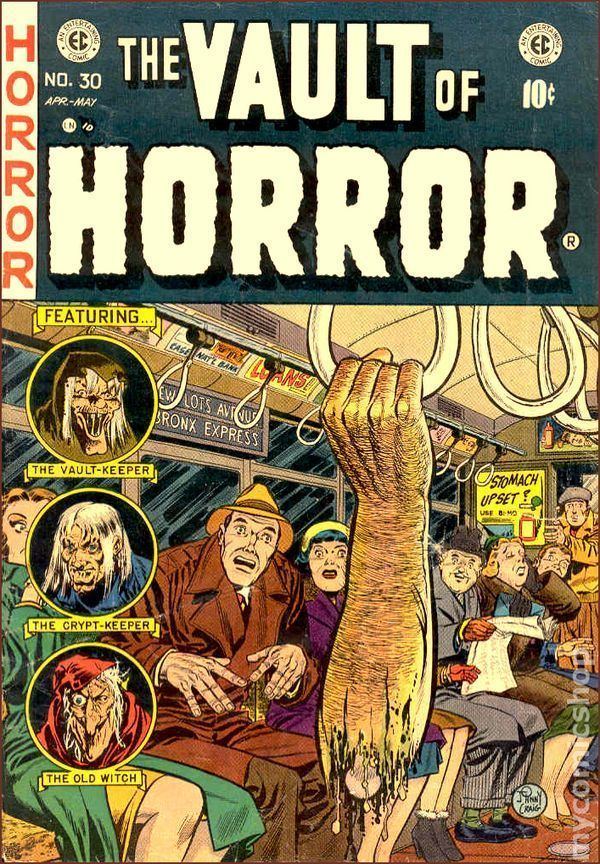
Origin

Horror comics emerged as a distinct comic book genre after World War II when young adult males lost interest in caped crimebusters and returning GIs wanted more potent themes in their reading. One-shot Eerie (1947) is generally considered the first true horror comic with its cover depicting a dagger-wielding, red-eyed ghoul threatening a rope-bound, scantily clad, voluptuous young woman beneath a full moon. In 1948, Adventures Into the Unknown became the first regularly published horror title, enjoying a nearly two decade lifespan.
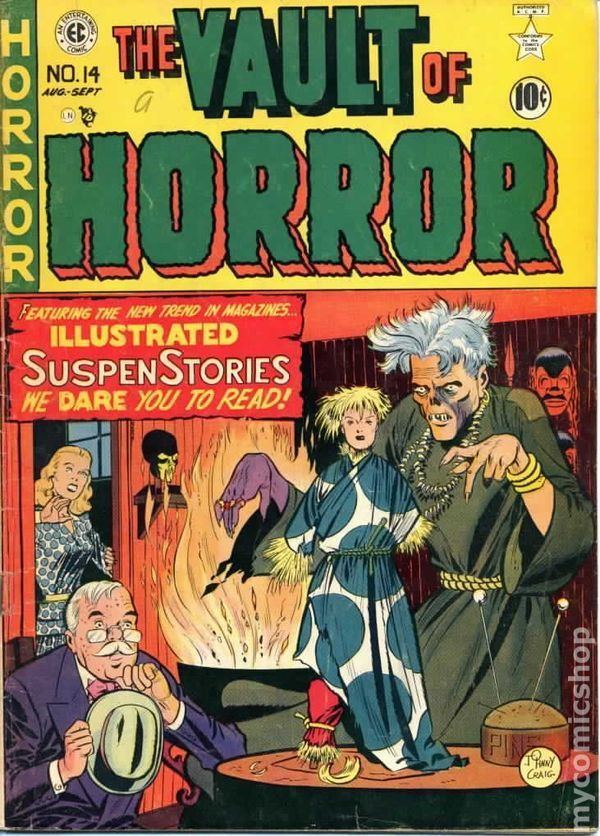
In 1950, William Gaines and his editor Al Feldstein discovered they shared similar tastes in horror and began experimenting with such stories in EC's crime comic War Against Crime and its companion title, Crime Patrol. With issue #12 the War Against Crime title was replaced with The Vault of Horror. The Vault-Keeper became the title's sardonic host and commentator, occasionally sharing duties with the Old Witch and the Crypt-Keeper. Due to an attempt to save money on second-class postage permits, characteristic of comics publishing of the era, the numbering did not change with the title; the first issue of The Vault of Horror was thus labelled "No. 12". There is, however, evidence of an intention to reset the series' numbering with the fourth issue (#15), as was done with The Haunt of Fear (the numbering of which was reset, yet also "continued" by Two-Fisted Tales: a few copies survive of the first issue of Crime SuspenStories with a different indicia on the inside front cover. As the Overstreet Comic Book Price Guide explains: "#15 (formerly The Vault of Horror)" printed and blackened out on inside front cover with "Vol.1, No.1" printed over it. Evidently, several of No.15 were printed before a decision was made not to drop the Vault of Horror and Haunt of Fear series. The print run was stopped on No.15 and continued on No.1. All of the No.15 issues were changed as described above."
Artists and writers
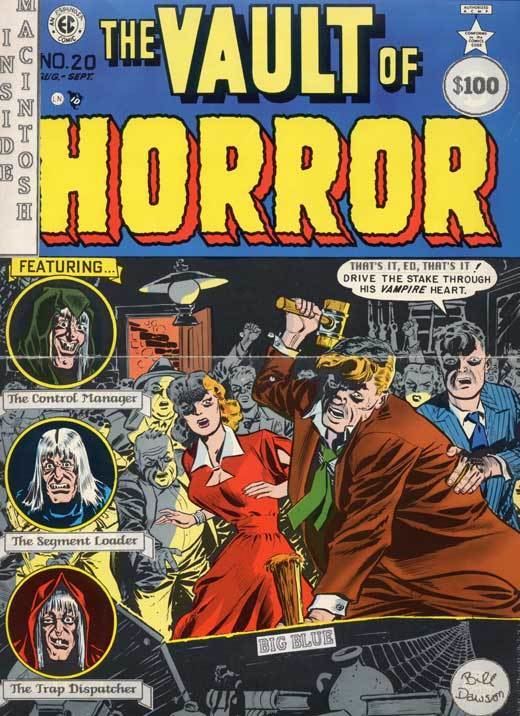
Like its horror companion titles, Tales from the Crypt and The Haunt of Fear, The Vault of Horror had its own distinctive qualities and atmosphere—in this case, created by its main artist, Johnny Craig. Craig illustrated all the covers for the entire run and was responsible for the lead story of all but issues #13 and #33. He also wrote all his own stories (save two) in Vault, something rarely done at EC, and became editor with issue #35 (February, 1954). Gaines and Feldstein wrote almost every other story until late 1953/early 1954 when outside writers Carl Wessler and Jack Oleck were brought in. Other contributing artists to The Vault of Horror were Feldstein, George Evans, Jack Kamen, Wally Wood, Graham Ingels, Harvey Kurtzman, Jack Davis, Sid Check, Al Williamson, Joe Orlando, Reed Crandall, Bernard Krigstein, Harry Harrison and Howard Larsen.
Influences and adaptations
As with the other EC comics edited by Feldstein, the stories in this comic were primarily based on Gaines reading a large number of horror stories and using them to develop "springboards" from which he and Feldstein could launch new stories. Specific story influences that have been identified include the following:


After their unauthorized adaptation of one of Ray Bradbury's stories in another magazine, Bradbury contacted EC about their plagiarism of his work. They reached an agreement for EC to do authorized versions of Bradbury's short fiction. These official adaptations include:
The Vault-Keeper
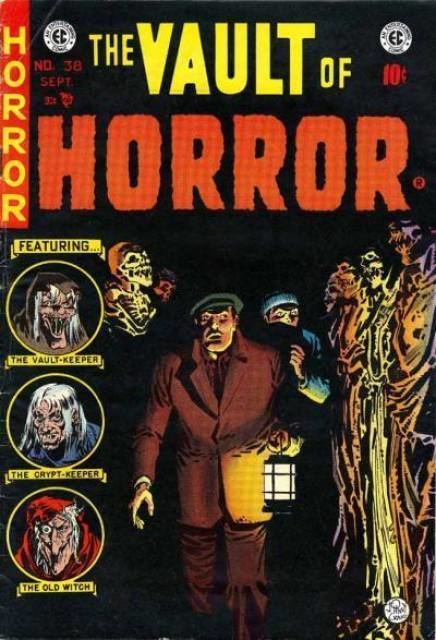
Although EC's horror stable consisted of three separate magazines, there was little beyond their titles to distinguish them. Each magazine had its titular host, but the hosting duties for any one issue were typically shared with the hosts of the other two. Thus, a single issue of The Vault of Horror would contain two stories told by the Vault-Keeper, one by the Crypt-Keeper (of Tales from the Crypt) and one by the Old Witch (of The Haunt of Fear). The professional rivalry between these three GhoulLunatics was often played for comic effect.
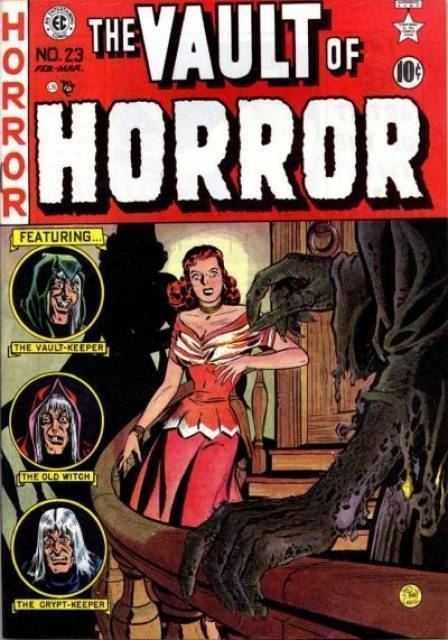
The Vault-Keeper was the primary host of The Vault of Horror. He was introduced to the public in War against Crime #10, and he continued in that magazine through its change in title and format. He was a frightening presence in those early issues, an ancient inquisitor, hooded and robed, presiding over the empty dungeon of his bloody past. But he soon evolved into a more comedic horror host, delivering an irreverent and pun-filled commentary to lighten the horrific tone of the stories he introduced.
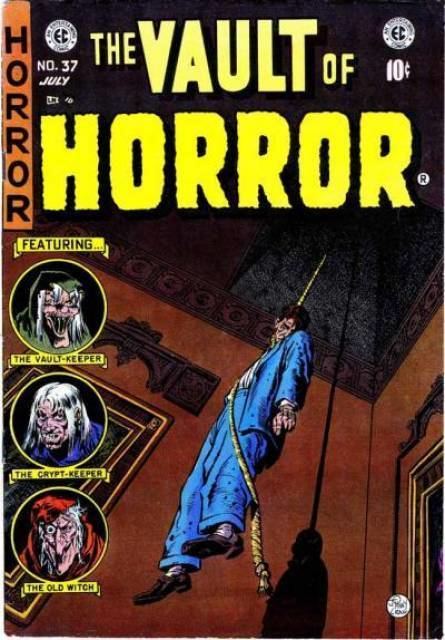
Although The Vault-Keeper was originally designed by Feldstein, Craig is the artist most associated with the character, having drawn all his lead stories in The Vault of Horror with the exception of two. Craig also drew the Vault-Keeper in his guest appearances in the other comics, although another artist frequently drew the rest of the story. For the final four issues of The Vault of Horror, The Vault-Keeper was joined by Drusilla, a beautiful but silent co-host in the Vampira mode.
Demise
In 1954, Gaines and Feldstein intended to add a fourth book to their horror publications by reactivating an earlier title, The Crypt of Terror. They were stopped dead in their tracks, however. American horror and other violent comics had come under scrutiny by moralizing parents, schoolteachers, clergymen, psychologists, and others who viewed the material as dangerous to the well-being of children and a significant contributor to the juvenile delinquency crisis in America (although the formulaic nature of the books usually resulted in truly immoral characters receiving a well-deserved, if gruesome, comeupance.) Matters came to a head in April and June 1954 with a highly publicized Senate Subcommittee on Juvenile Delinquency. Hearings targeted violent comic books—which fared poorly in the proceedings. While the committee stopped short of blaming the comics industry for juvenile delinquency, they did suggest it tone down the product. Publishers were left reeling.
The industry deftly avoided outside censorship by creating the self-regulatory Comics Magazine Association of America (CMAA) and a Comics Code Authority (CCA) that placed severe restrictions on violent comic book genres. Publishers were forbidden from using the words "terror" and "horror" in titles, for example, and forbidden from depicting zombies, werewolves and other gruesome characters and outré horror fiction trappings. Gaines was fed up; he believed his titles were being specifically targeted and realized they were doomed to future failure. He cancelled The Vault of Horror and its companion titles in September 1954. The last issue of Vault was its 29th (cover label #40, December/January 1955). Since an issue of The Crypt of Terror had already been produced, it was published as the 27th and final issue of Tales from the Crypt (#46, February/March, 1955).
Reprints
The Vault of Horror has been reprinted on numerous occasions. Ballantine Books reprinted selected Vault stories in a series of paperback EC anthologies in 1964–66. Other Vault stories were reprinted in Horror Comics of the 1950s by Nostalgia Press (1971), edited by Bhob Stewart and Ron Barlow. Publisher Russ Cochran released six issues of his EC Portfolio (1971–77). East Coast Comix reprinted issue #26 in the early 1970s. The magazine was fully collected in a series of five black-and-white hardbacks by Cochran as part of The Complete EC Library in the early 1980s. Cochran also reprinted the title in a standard comic book format (out of sequence) during the early 1990s in association with Gladstone Publishing. Cochran eventually reprinted the run in proper sequence during the later 1990s with Gemstone Publishing. This complete run was later rebound, with covers included, in a series of six softcover EC Annuals. In 2007, Cochran and Gemstone began to publish hardcover, re-colored volumes of The Vault of Horror as part of the EC Archives series. One volume (of a projected five) was published by Gemstone before their financial troubles left the project in limbo. A second volume was published by GC Press LLC, a boutique imprint established by Russ Cochran and Grant Geissman, in January 2012. But the project may soon be revived under a new publisher, since Dark Horse Comics has announced plans to resume it with the release of The Vault of Horror Volume 3 in January 2014.
Media adaptations
The Vault of Horror stories were adapted to motion pictures in Freddie Francis' Tales from the Crypt (1972) and Roy Ward Baker's The Vault of Horror (1973).
Vault stories were also adapted for the Tales from the Crypt television series that aired on HBO (1989). The following stories were used in the television series: Horror in the Night (Issue #12), Doctor of Horror (#13), Report from the Grave (#15), Fitting Punishment (#16), Werewolf Concerto (#16), Revenge Is the Nuts (#20), The Reluctant Vampire (#20), Dead Wait (#23), Staired in Horror (#23), 99 & 44/100% Pure Horror (#23), Collection Completed (#25), Seance (#25), Half-Way Horrible (#26), People Who Live in Brass Hearses (#27), 'Til Death (#28), Split Personality (#30), Easel Kill Ya (#31), Whirlpool (#32), Strung Along (#33), Let The Punishment Fit The Crime (#33), A Slight Case of Murder (#33), Smoke Wrings (#34), And All Through the House (#35), Beauty Rest (#35), Surprise Party (#37), Top Billing (#39) and The Pit (#40).
The Vault-Keeper appeared as a character in the 1993 animated series Tales from the Cryptkeeper.
